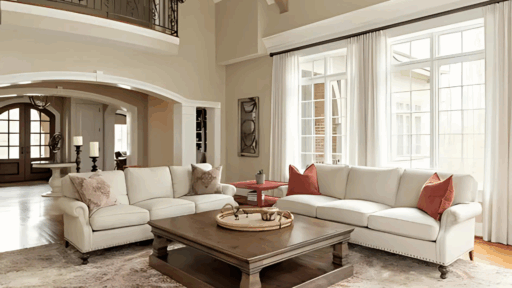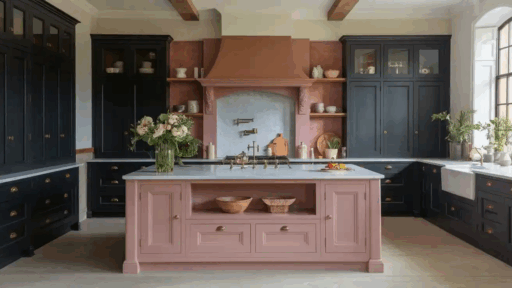If you’re looking for colors that complement Sherwin-Williams Wool Skein(SW 6148), this article is for you.
Wool Skein is a soft, warm beige that works beautifully in nearly any room.
In this post, I’ll explain the best trim and accent color options, offer room-by-room suggestions, and provide easy-to-apply color theory insights to help you choose confidently.
I’ll also go through how to enhance your interiors with striking colors and varied materials that add dimension and warmth.
If you’re feeling uncertain about pairing colors with Wool Skein, don’t worry – I’ll clarify everything.
This guide is designed to be clear and helpful, offering tested insights that simplify the color-matching process.
What Is Sherwin-Williams Wool Skein?

Sherwin-Williams Wool Skein is a soft, warm neutral. It’s a light beige with subtle yellow and tan undertones.
With a Light Reflectance Value (LRV) of 63, it reflects a good amount of light, making it suitable for both well-lit and low-light rooms.
These warm hues give it an inviting, natural appearance without making the space feel dark or heavy.
Wool Skein complements a variety of design styles, traditional, modern, rustic, and farmhouse alike. It maintains brightness without appearing washed out.
It won’t absorb excessive light like deeper shades often do. Wool Skein is a simple, warm, and versatile choice, one of the more widely used shades in its category.
Complementary Colors That Pair Well with Wool Skein
Wool Skein is a warm, neutral shade of paint. To add dimension or contrast, pair it with cooler tones, deeper accents, or earthy shades.
Cool Colors for Balance

Cool shades are a reliable choice to offset the warmth of Wool Skein. They reduce visual heaviness and create a calmer setting.
Sea Salt (SW 6204) features a gentle green-blue tint that feels clean and light, making it especially useful in smaller areas, such as bathrooms.
Comfort Gray (SW 6205) offers a soft blue-gray tone and is well-suited for bedrooms or quiet corners. Both colors provide contrast without making the space feel stark.
Darker Accent Colors

To bring focus or variation, I sometimes opt for stronger accent tones. Wool Skein works well as a background, letting deeper shades take the lead.
Naval (SW 6244) is a dark navy that holds attention on features like a wall or kitchen island. It introduces depth while staying refined.
Urbane Bronze (SW 7048) is a rich, charcoal-brown with a muted character. These tones pair well with Wool Skein because they create contrast and structure without overwhelming the space.
Muted, Earth-Inspired Colors

For a more grounded palette, I choose nature-based tones. Sage Greens, Terracotta Tones, and Oak Leaf Brown all coordinate with Wool Skein’s warmth.
These shades echo natural materials and suit interiors with a relaxed or organic theme. Use them in gathering spaces.
This shade creates a welcoming and composed environment. They don’t dominate, but they add texture and visual interest.
Best White Trim Colors for Wool Skein
Selecting the right white trim can significantly impact how Wool Skein appears in your space.
Crisp White Trim Choices

For a refreshed and contemporary appearance, I prefer using crisp, white tones. These provide noticeable contrast with Wool Skein, making edges appear more defined.
Extra White (SW 7006) is a frequent choice since it’s clean but not overly stark. For the most radiant white available, I choose High Reflective White (SW 7757).
It provides a sleek visual next to the warm beige. These types of whites work well in modern, minimal, or transitional interiors where clarity and contrast are key.
Soft White Trim Choices

If I want the space to feel cozier and more at ease, I lean toward whites with subtle warmth. They still read as clean, but blend smoothly with the neutral base of Wool Skein.
Alabaster (SW 7008) is a long-time favorite due to its creamy tone. Greek Villa (SW 7551) is another strong pick when I need a warmer white that’s just a touch brighter.
These shades suit farmhouse, rustic, or cottage-style interiors, where comfort is a key priority. These shades complement the atmosphere naturally.
Choosing the Right Accent Colors for Wool Skein
Wool Skein offers a warm, adaptable base. Selecting the right accents can enhance the palette without overwhelming it. Here’s how to approach color pairing:
- Balance the Warmth with Cooler Shades: Soft blues and muted greens help offset the warmth of Wool Skein. These tones create contrast without appearing harsh.
- Use Deeper Colors in Moderation: Navy, charcoal, and forest green provide depth and visual focus. They work well on focal walls, furniture pieces, or cabinetry.
- Incorporate an Earth-Inspired Tone: Shades such as terracotta, clay, and sage green complement Wool Skein’s tone. These colors complement rustic or nature-inspired interiors well.
- Match Accents to the Room’s Purpose: For a more relaxed setting, opt for soft, calm tones. For emphasis or contrast, consider deeper, darker shades. For warmth, select natural, muted colors
- Keep Accent Colors Limited: Restrict accents to one strong or two softer colors per space. This helps maintain clarity in the design.
Wool Skein: Color Pairing by Room
Wool Skein serves as a versatile foundation that can be used throughout the home. What changes from room to room is how it interacts with trim, furnishings, and other color elements.
Living Room

In a living area, Wool Skein offers a neutral wall tone that complements a wide range of styles. Pair it with light trim shades, such as Alabaster or Extra White.
For a visual contrast, incorporate accents such as navy blue pillows or a blue armchair, which offer color variation without being overpowering.
Kitchen

Wool Skein works well on kitchen walls because it delivers a soft neutral tone that supports both light and darker features.
Try deep green or navy lower cabinets to introduce contrast in spaces with a traditional or transitional look. Brass or matte black hardware adds a modern touch that complements well.
Bedroom

In bedrooms, Wool Skein contributes to a setting that feels relaxed and neutral. It pairs easily with white bedding – whether cotton or linen – to keep the space looking refreshed.
Pale gray or soft blue accents in pillows, curtains, or artwork add subtle contrast while maintaining a balanced atmosphere.
Bathroom

In bathrooms, Wool Skein helps bridge the look of hard surfaces and neutral wall color. It works particularly well with gray or blue tile, which brings in cooler tones that complement its warmth.
Light trim is especially effective in smaller bathrooms, as it maintains clarity in the design. Adding wooden shelves, a framed mirror, or bamboo accessories offers texture and material variation.
Sample Color Palettes With Sherwin-Williams
Wool Skein is a warm, adaptable neutral that integrates seamlessly with a wide variety of design styles. Its versatility makes it a strong choice for many types of spaces.
Palette 1: Soft Neutrals

This combination emphasizes warmth and gentle transitions. It works well in spaces intended for ease and restfulness.
- Wool Skein (SW 6148): Use as the primary wall color or even on ceilings. It provides a balanced backdrop without appearing overly pronounced.
- Alabaster (SW 7008): A warm-toned white for trims, doors, or cabinetry. It blends seamlessly with Wool Skein and avoids stark contrast.
- Dried Thyme (SW 6186): A muted green that works for accent features like a single wall, cabinetry, or accessories such as curtains or cushions.
This palette is ideal for bedrooms, family rooms, or reading areas. Include woven rugs, layered textiles, wooden furnishings, and natural lighting to support a sense of comfort.
Palette 2: Updated Farmhouse

This grouping blends rustic finishes with structured contrasts. It’s suited for interiors that balance traditional elements with modern touches.
- Wool Skein (SW 6148): Acts as a consistent base for walls across open-plan layouts or transitional zones.
- Iron Ore (SW 7069): A dark, near-black tone suitable for lower cabinets, doors, or key furniture pieces.
- Greek Villa (SW 7551): A soft, creamy white that functions well for trim, ceilings, or interior molding.
Use Wool Skein on primary surfaces, apply Greek Villa for framework areas, and incorporate Iron Ore for a stronger contrast to enhance the visual structure.
Palette 3: Coastal Tones

Ideal for interiors that aim to feel open and gently refreshed, this set is inspired by natural elements often found in light-filled environments.
- Wool Skein (SW 6148): Offers a warm base that doesn’t lean too yellow or sandy.
- Sea Salt (SW 6204): A subtle blue-green that introduces a cool note without dominating the palette. Works well on feature walls, cabinetry, or larger pieces of furniture.
- Pure White (SW 7005): A clean white that defines trim, ceilings, and framing details.
Complement it with materials such as cotton bedding, woven baskets, seagrass mats, and weathered wood pieces.
How to Use Bold Colors and Texture with Wool Skein
Here’s how I like to use bold colors and textures with Wool Skein to keep the space warm, balanced, and interesting:
- Start with One Focal Element: Try a navy sofa, dark green cabinet, or black island to ground the room.
- Keep the Surroundings Light: Use Wool Skein on walls, with soft trim and minimal accents.
- Add Natural Materials: Wood, linen, jute, and rattan ease the contrast and add warmth.
- Use Deep Tones: Charcoal gray, deep green, and navy work beautifully with Wool Skein.
- Avoid Bright Hues: Skip sharp or electric colors—they clash with Wool Skein’s softness.
- Layer Texture: Use woven rugs, linen curtains, wood furniture, and cane accents to add depth without needing more color.
This approach keeps your space feeling cozy, natural, and thoughtfully styled.
Colors to Avoid with Wool Skein
The right combinations help enhance a room, while certain shades may create visual disconnection or reduce overall cohesion.
| Avoid These Colors | Why They Clash | Better Alternatives |
|---|---|---|
| Cool Blue-Grays | Contrast feels harsh and disjointed, especially in soft lighting | Try Sea Salt (SW 6204) or Comfort Gray (SW 6205) |
| Jet Black Trim | Too stark and high contrast for Wool Skein’s warmth | Use Iron Ore (SW 7069) or Urbane Bronze (SW 7048) |
| Bright Reds (e.g., Cherry Red) | Overpowers the subtle, neutral tone of Wool Skein | Consider Muted Terracotta or Burnt Sienna |
| Lemon Yellow | Too saturated and vibrant, feels disconnected | Go for Ochre or Warm Mustard |
| Royal Purple | Visually heavy and overly intense | Use Dusty Plum or Muted Mauve |
Tips for Testing Complementary Colors
The appearance of paint can shift significantly depending on the lighting, time of day, and surrounding materials.
- Apply Color Directly to the Wall: Avoid relying solely on printed or painted swatches. Instead, paint a large sample area directly on the intended surface.
- Evaluate in Different Lighting Conditions: Lighting affects how Wool Skein appears – morning light makes it cooler, evening light warms it, and artificial lighting can deepen its beige tone.
- Consider Peel-and-Stick Samples: Removable painted samples are a clean and flexible way to preview color. Apply them to multiple walls near windows, corners, or light fixtures.
Conclusion
Wool Skein is a warm-toned neutral with broad applicability across many interior settings. Its adaptability allows it to coordinate with a range of color groupings and materials.
Achieving a well-balanced result depends on a few thoughtful choices. Consider combining Wool Skein with cooler accents, clean or soft whites, deeper tones, and organic textures.
These elements help create contrast, clarity, or visual depth, depending on the room and its lighting.
Before finalizing any palette, it’s best to apply test samples and observe them under both natural and artificial lighting.
Look how they appear throughout the day. Once you’re confident with the primary color, you can refine the space by adding trim shades, finishes, and materials that align with the overall room.








